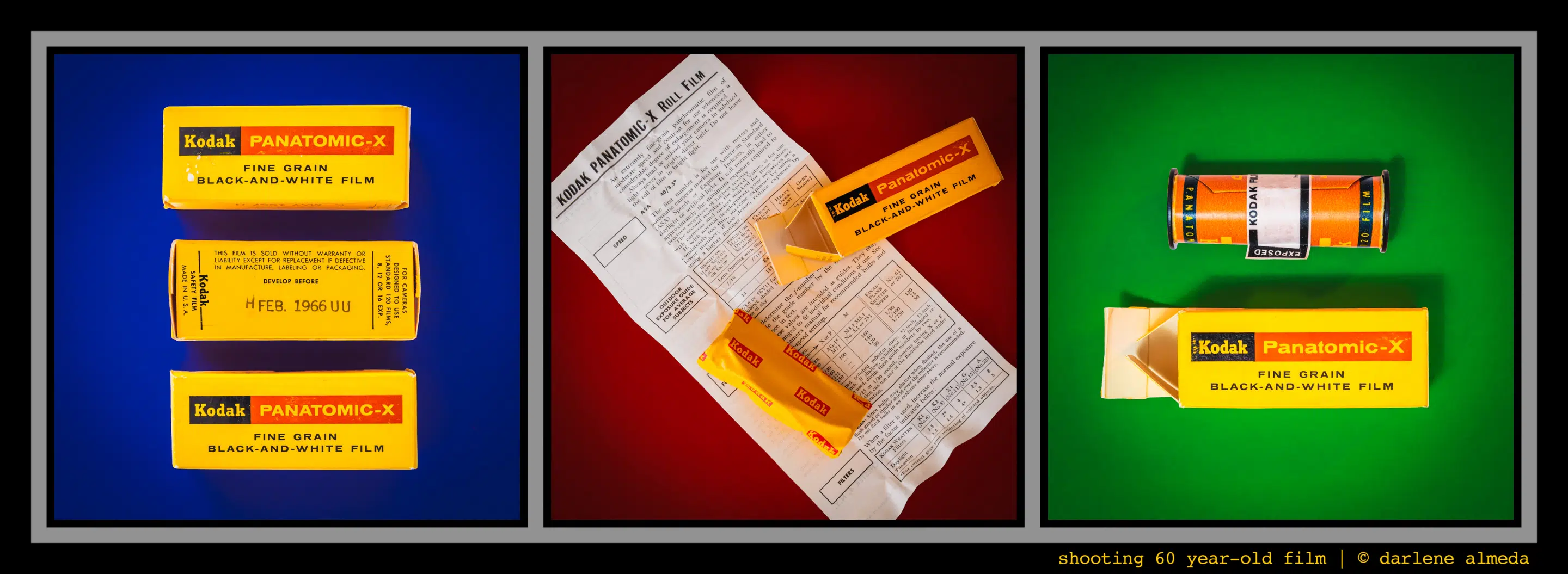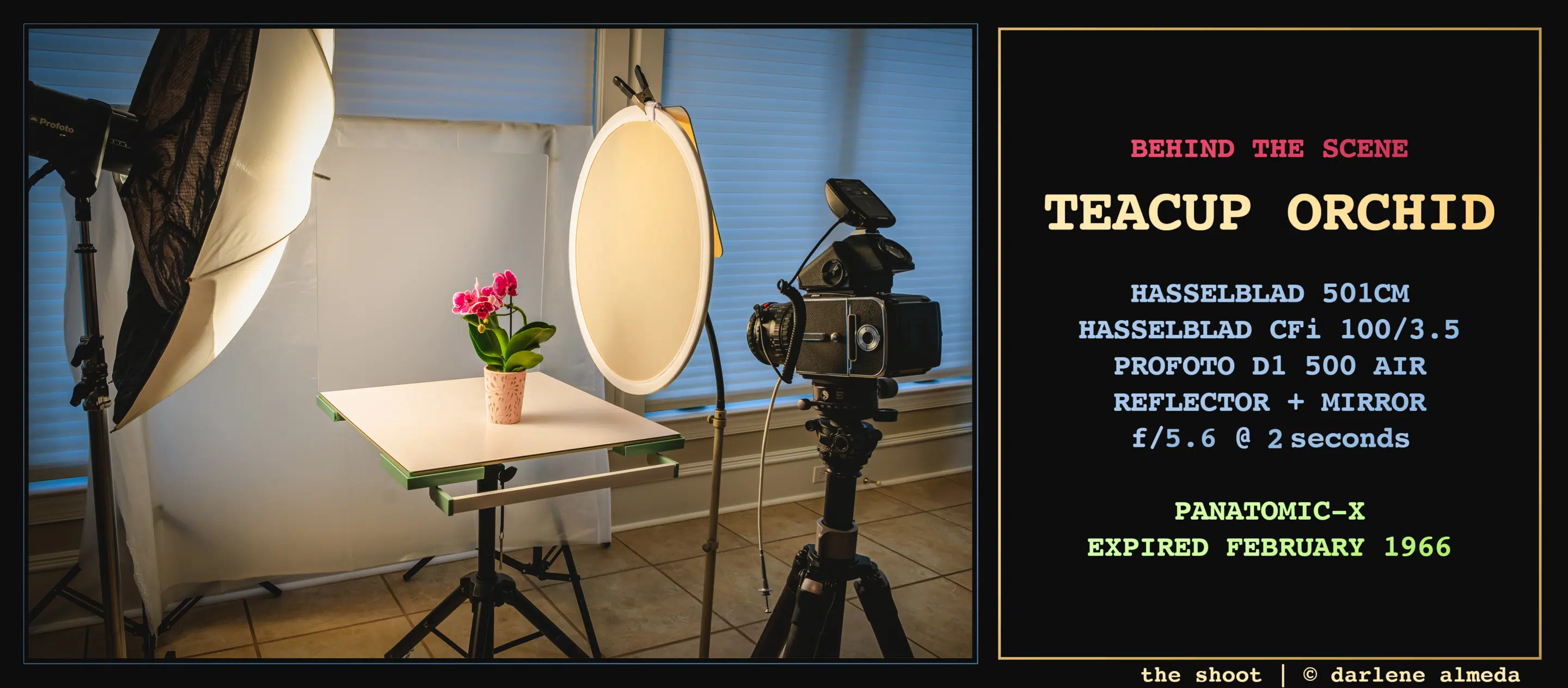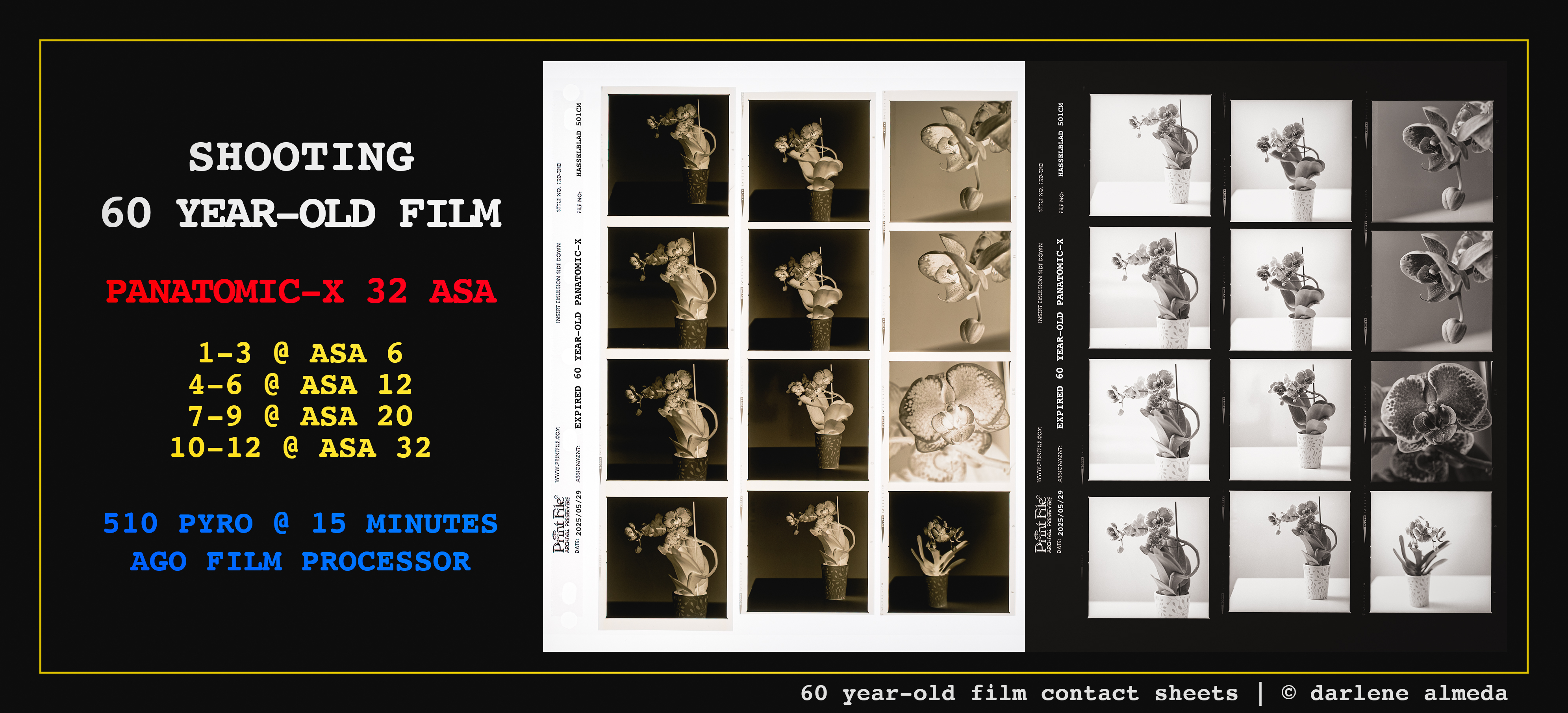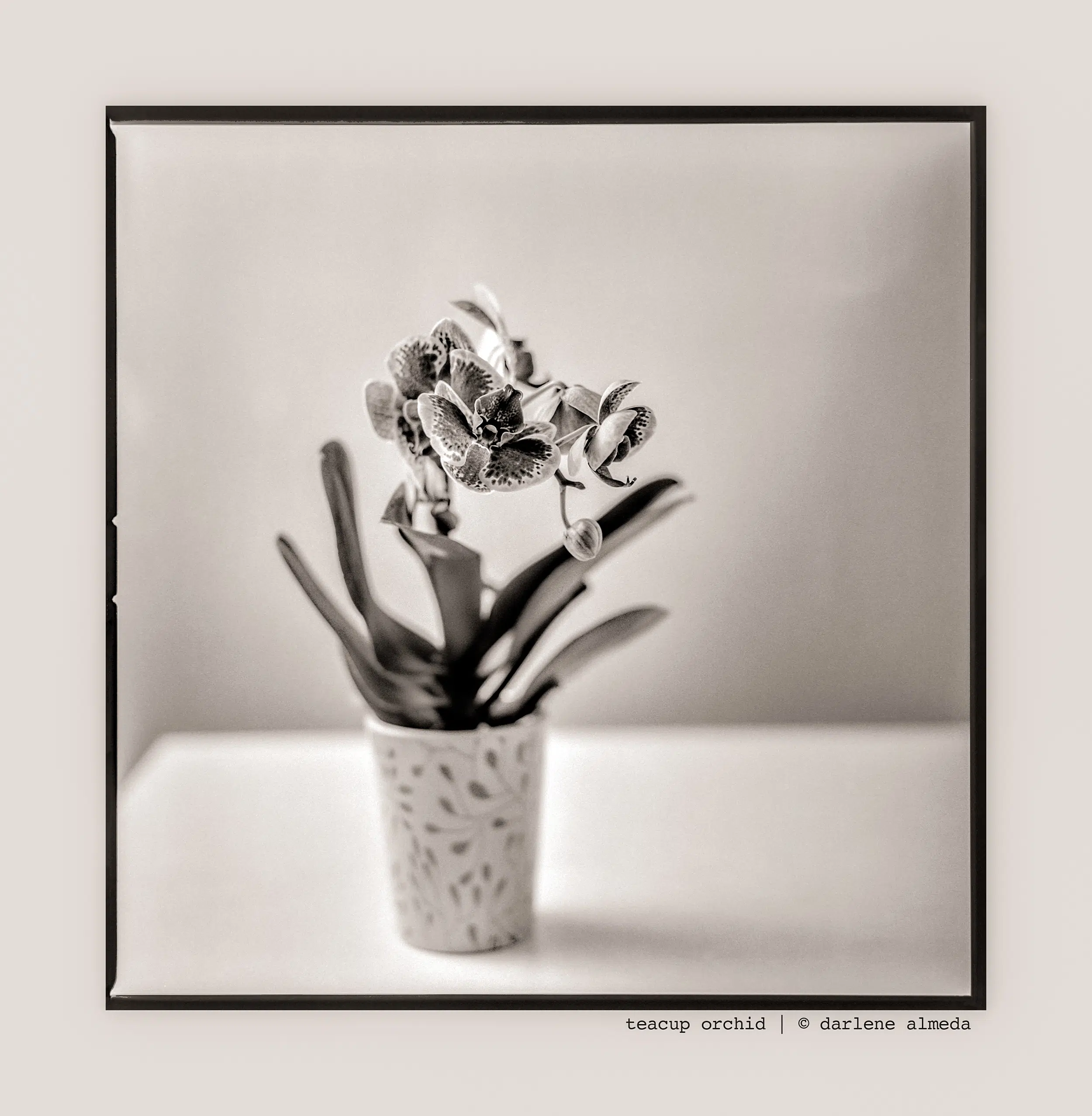PANATOMIC-X 120 FILM: EXPIRED 02/1966 & 05/1967
Ever get the urge to shoot some ancient expired film—just to see if you’re lucky or just plain crazy? I’m talking seriously old stuff here.
A few months ago, the film gods dangled a deal in front of me: three rolls of Kodak Panatomic-X, one of my long-lost loves, for a price I couldn’t pass up. I caved instantly.
The last time I shot this film, I still had a student ID and thought mullets might make a comeback. Yes, it’s been that long. Kodak officially discontinued it in 1987 after having a long run since 1933.
This article walks through how I successfully shot a roll of Kodak Panatomic-X that’s been aging for over 60 years—and how do I know that? Well, the expiration date on the box I used says February 1966. That’s not just expired—that’s vintage.
THE SHOOT
THE MAKING OF TEACUP ORCHID
If you’ve ever researched how to shoot expired film, you’ve probably run into the classic advice: “Add one stop of exposure for every decade it’s been expired.” Sounds simple, right? Well, that’s not exactly what I did.
This article proves that when you have no idea—zero clue—how a roll of film has been stored over the past 60+ years (mine is older than disco), you’ll need to get creative if you want even one decent frame.
Surprisingly, I ended up with two images I like and had a positive experience overall. What made the difference? A handful of very intentional—and admittedly experimental—choices:
- Film Format: I shot 6×6 and broke the roll into four sections, each with a different exposure approach.
- Lenses: I changed the lens (100mm, 120 macro, 120 macro + tube, and 180mm) in each section to see how much that affected contrast or sharpness.
- Lighting: I used studio strobes and dragged the shutter to blanket the scene with extra light and soften shadows.
- Pre-Soak: I gave the film a five-minute water bath before development—good call, if I do say so.
- Development: I skipped semi-stand/stand development (too risky with fragile emulsion) and used my AGO processor instead: 15-minute development with standard agitation steps.
And the result? It worked! The first nine frames came out a little hot—classic Panatomic-X contrast punch—but they’re absolutely printable. The last three, shot with the Hasselblad CFi 120 macro and variable extension tube, are a bit underexposed but still salvageable.
Moral of the story? When in doubt, experiment like a mad scientist—but keep your notes in case it actually works.
THE RESULTS
PANATOMIC-X 60 YEARS-OLD / CONTACT SHEETS
I use the Notes app on my iPhone to keep track of things while I’m shooting—quick notes, exposure info, lens changes, lighting setups, you name it. Lately, I’ve started using the voice recording feature, too, and I have to say: it’s growing on me. When you’re juggling film, lights, lenses, and a ticking storm front, talking to your phone feels a whole lot easier than typing.
And that storm? It’s the only reason this shoot even happened.
We were all set to hit the road for a few days—RV packed, plans made—but the weather had other plans. A few days out, the forecast whispered, “possible severe weather.” Twenty-four hours before departure, it started shouting. I’m not one to be trapped inside a camper with sideways rain rattling the windows, so we pulled the plug, preserving both our sanity and our deposit for another time.
Instead, I redirected my energy into the studio to finally shoot that prehistoric roll of Panatomic-X. But here’s the twist: that same storm system was now bearing down on us at home. Firing power-hungry studio strobes at full output (10 amps each) while thunder rumbled outside? Not exactly calming—and I know better. Still, I kept the session streamlined: lenses ready, electronics synced, film loaded without issue. Showtime. I logged each setup in the Notes app and recorded voice memos for every frame to keep the details straight.
Here’s the breakdown:
- Frames 1, 2, 3: CFi 120/4 Macro | ASA 6 | f/5.6 @ 1 sec
- Frames 4, 5, 6: CFi 180/4 | ASA 12 | f/5.6 @ 1 sec
- Frames 7, 8, 9: CFi 100/3.5 | ASA 20 | f/5.6 @ 2 sec
- Frames 10, 11, 12: CFi 120/4 Macro + Vari-Tube | ASA 32 | f/5.6 @ 4 sec
All the frames came out acceptable—thank you, ancient Kodak gods—and while there are a few technical quirks here and there (it is 1966 film, after all), I’m pleased. Composition-wise, frame #9 is the standout for me. Funny how the one you least expect sometimes rises to the top.
FRAME #9: TEACUP ORCHID
FRAME #9: TEACUP ORCHID
I tend to use out-of-focus as a creative tool—or, let’s be honest, a creative indulgence—case in point: Teacup Orchid. The softness was entirely intentional. And when you’re shooting at ASA 6, 12, 20, or 32 and don’t feel its a smart idea to double or triple-pop the strobes for more depth of field during a thunder storm—or dragging out yet another light—you can confidently tell yourself (and anyone who asks) that the blur was art. Sometimes laziness and style go hand-in-hand.
By the time I wrapped up the shoot, thunder was rattling the windows, and lightning had rolled in again. Good timing—or maybe just barely.
When it came to development, I didn’t mess around. I’d read the cautionary tales from brave souls who dared to process film this old—words like “sticky,” “gummy,” and “weirdly soft” came up more than I’d like. Mine wasn’t sticky, thank goodness, but it did feel suspiciously thin, and it curled up like my hair did when Granny broke out the pink sponge rollers and declared me pageant-ready. But I digress. One frame had a few mysterious dark flecks drifting around, but overall, the roll looked shockingly clean, for something that might’ve heard “These Boots Are Made for Walkin'” on the radio when it was still topping the charts.
I don’t always pre-wash, but this time I did—and wow, was that the right call. When I poured out the pre-wash water, it was pitch black. Think Creature from the Black Lagoon levels of murky. (Fitting, since that film was shot not too far from where I live.) Honestly, I half expected a clawed hand to reach up out of the tank. Thankfully, it was just the film doing a dramatic purge.
I did a 5-minute pre-wash because the film was at least 60 years old, and with film that old, there’s often degraded emulsion and residual dyes or backing stains that can leach out. The pre-wash helps soften the emulsion gently, allows the gelatin to swell evenly, and flushes out any soluble degradation products before development begins. In this case, the pre-wash water came out nearly pitch black — a clear sign it had removed quite a bit of that material. That not only prevents staining but also helps ensure more even development across the frame. A longer pre-wash can be the difference between usable and blotchy results for very old or poorly stored film.
I programmed the AGO processor for a 15-minute run using my usual developer: 510 Pyro. I mix it with refrigerated, filtered water and cut it with room-temperature distilled water to bring the final temp to 68°F. It was a smooth, uneventful process—the kind you hope for when handling antique emulsions. I gave the film a one-minute Photo-Flo bath, then let it hang to dry overnight.
I digitized the negatives the following day using my APS-C camera and a Negative Supply 120 pro film carrier on a Skier Copy Box. After that, it was slice, store, and file: each strip carefully placed in Print File pages for contact sheets and safekeeping.
So yes, I survived the storm, the ancient film, and a monster-grade pre-soak. And I even got a couple of images to show for it. Not bad for a canceled holiday trip.
FRAME #6: TEACUP ORCHID
FRAME #6: TEACUP ORCHID
CLOSING STATEMENT
In the end, what started as a holiday bust turned into a memorable studio session with a roll of film, the age of my classic Sinar Norma. There’s something oddly satisfying about coaxing images out of expired stock, stormy skies, and a little creative blur. It reminds me that photography isn’t always about perfect conditions—it’s about making something meaningful with what you’ve got, when you’ve got it. And if that means shooting by stormlight with ancient film and a dash of stubborn optimism, that’s a celebration in its own right.
The Panatomic-X I shot here expired in February 1966—but that was only the beginning for me. I was just a wee little girl listening to guitars in the classroom at Topanga Elementary, chasing horned toads, catching tadpoles, and living my best life with my first of a few boyfriends named Johnny. How about you? Were you even born?





